Kingdom Fungi Rank Species Order Agaricales | Phylum Basidiomycota Higher classification Amanita | |
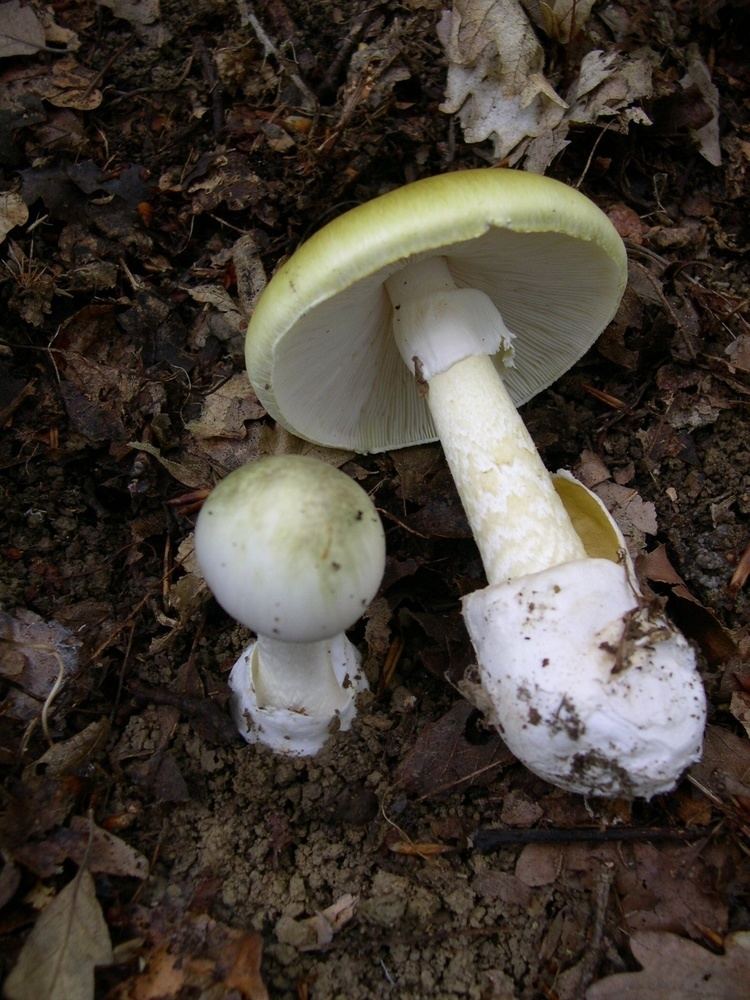 | ||
Similar Fly agaric, Amanita pantherina, Amanita virosa, Russula, Amanita verna | ||
Amanita phalloides /æməˈnaɪtə fəˈlɔɪdiːz/, commonly known as the death cap, is a deadly poisonous basidiomycete fungus, one of many in the genus Amanita. Widely distributed across Europe, A. phalloides forms ectomycorrhizas with various broadleaved trees. In some cases, the death cap has been introduced to new regions with the cultivation of non-native species of oak, chestnut, and pine. The large fruiting bodies (mushrooms) appear in summer and autumn; the caps are generally greenish in colour, with a white stipe and gills.
Contents
- Taxonomy and naming
- Description
- Distribution and habitat
- Toxicity
- Similarity to edible species
- Biochemistry
- Signs and symptoms
- Treatment
- Notable victims
- References

These toxic mushrooms resemble several edible species (most notably caesar's mushroom and the straw mushroom) commonly consumed by humans, increasing the risk of accidental poisoning. Amatoxins, the class of toxins found in these mushrooms, are thermostable: they resist changes due to heat and so, unlike many ingested poisons, their toxic effects are not reduced by cooking. Some amatoxins may cause irritation and severe pain and even damage to the eyes and skin on contact, however they can't be absorbed through the skin or through inhalation and only eating them causes the toxin's effect.
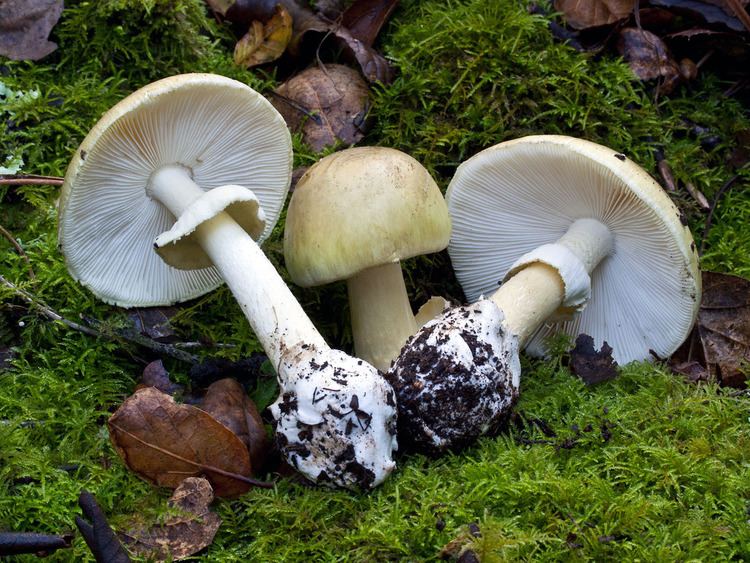
A. phalloides is one of the most poisonous of all known toadstools. It is estimated that as little as half a mushroom contains enough toxin to kill an adult human. It has been involved in the majority of human deaths from mushroom poisoning, possibly including the deaths of Roman Emperor Claudius in AD 54 and Holy Roman Emperor Charles VI in 1740. It has been the subject of much research, and many of its biologically active agents have been isolated. The principal toxic constituent is α-amanitin, which damages the liver and kidneys, causing hepatic and renal failure that can be fatal.
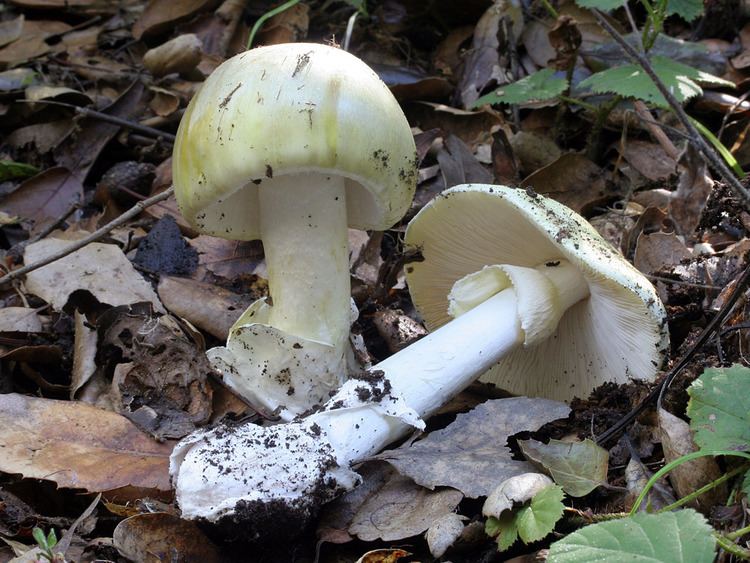
Taxonomy and naming
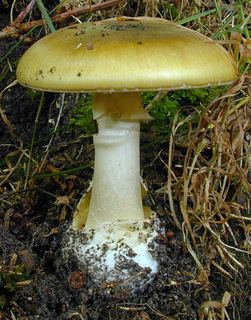
The death cap is named in Latin as such in the correspondence between the English physician Thomas Browne and Christopher Merrett. and was described by French botanist Sébastien Vaillant in 1727, who gave a succinct phrase name "Fungus phalloides, annulatus, sordide virescens, et patulus", which is still recognizable as the fungus today. Though the scientific name phalloides means "phallus-shaped", it is unclear whether it is named for its resemblance to a literal phallus or the stinkhorn mushrooms Phallus. In 1821, Elias Magnus Fries described it as Agaricus phalloides, but included all white amanitas within its description. Finally in 1833, Johann Heinrich Friedrich Link settled on the name Amanita phalloides, after Persoon had named it Amanita viridis 30 years earlier. Although Louis Secretan's use of the name Amanita phalloides predates Link's, it has been rejected for nomenclatural purposes because Secretan's works did not use binomial nomenclature consistently; some taxonomists have, however, disagreed with this opinion.
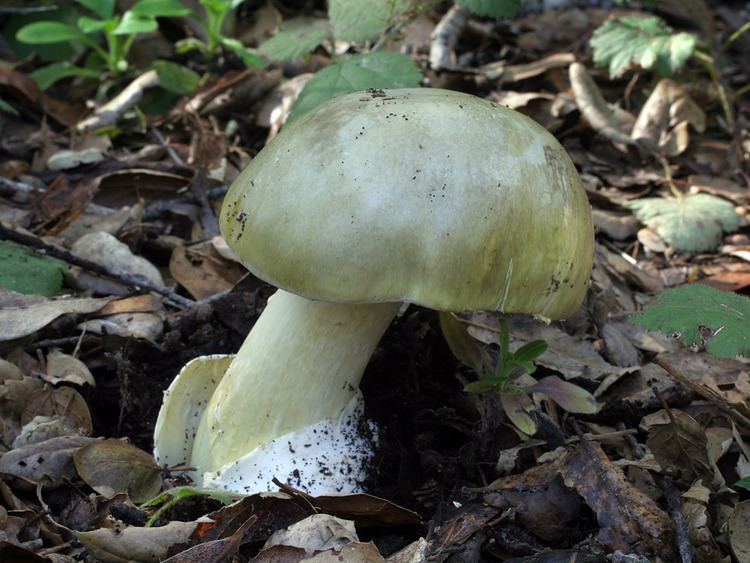
Amanita phalloides is the type species of Amanita section Phalloideae, a group that contains all of the deadly poisonous Amanita species thus far identified. Most notable of these are the species known as destroying angels, namely Amanita virosa and Amanita bisporigera, as well as the fool's mushroom (A. verna). The term "destroying angel" has been applied to A. phalloides at times, but "death cap" is by far the most common vernacular name used in English. Other common names also listed include "stinking amanita" and "deadly amanita".
A rarely appearing, all-white form was initially described A. phalloides f. alba by Max Britzelmayr, though its status has been unclear. It is often found growing amid normally colored death caps. It has been described, in 2004, as a distinct variety and includes what was termed A. verna var. tarda. The true Amanita verna fruits in spring and turns yellow with KOH solution, whereas A. phalloides never does.
Description
The death cap has a large and imposing epigeous (aboveground) fruiting body (basidiocarp), usually with a pileus (cap) from 5 to 15 cm (2 to 6 in) across, initially rounded and hemispherical, but flattening with age. The color of the cap can be pale-, yellowish-, or olive-green, often paler toward the margins and often paler after rain. The cap surface is sticky when wet and easily peeled, a troublesome feature, as that is allegedly a feature of edible fungi. The remains of the partial veil are seen as a skirtlike, floppy annulus usually about 1.0 to 1.5 cm (0.39 to 0.59 in) below the cap. The crowded white lamellae (gills) are free. The stipe is white with a scattering of grayish-olive scales and is 8 to 15 cm (3 to 6 in) long and 1 to 2 centimetres (3⁄8 to 3⁄4 in) thick, with a swollen, ragged, sac-like white volva (base). As the volva, which may be hidden by leaf litter, is a distinctive and diagnostic feature, it is important to remove some debris to check for it.
The smell has been described as initially faint and honey-sweet, but strengthening over time to become overpowering, sickly-sweet and objectionable. Young specimens first emerge from the ground resembling a white egg covered by a universal veil, which then breaks, leaving the volva as a remnant. The spore print is white, a common feature of Amanita. The transparent spores are globular to egg-shaped, measure 8–10 μm (0.3–0.4 mil) long, and stain blue with iodine. The gills, in contrast, stain pallid lilac or pink with concentrated sulfuric acid.
Distribution and habitat
The death cap is native to Europe, where it is widespread. It is found from the southern coastal regions of Scandinavia in the north, to Ireland in the west, east to Poland and western Russia, and south throughout the Balkans, in Italy, Spain and Portugal, and in Morocco and Algeria in north Africa. In west Asia it has been reported from forests of northern Iran. There are records from further east in Asia but these have yet to be confirmed as A. phalloides.
It is ectomycorrhizally associated with several tree species and is symbiotic with them. In Europe, these include hardwood and, less frequently, conifer species. It appears most commonly under oaks, but also under beeches, chestnuts, horse-chestnuts, birches, filberts, hornbeams, pines, and spruces. In other areas, A. phalloides may also be associated with these trees or with only some species and not others. In coastal California, for example, A. phalloides is associated with coast live oak, but not with the various coastal pine species, such as Monterey pine. In countries where it has been introduced, it has been restricted to those exotic trees with which it would associate in its natural range. There is, however, evidence of A. phalloides associating with hemlock and with genera of the Myrtaceae: Eucalyptus in Tanzania and Algeria, and Leptospermum and Kunzea in New Zealand. This suggests the species may have invasive potential.
By the end of the 19th century, Charles Horton Peck had reported A. phalloides in North America. In 1918, samples from the eastern United States were identified as being a distinct though similar species, A. brunnescens, by G. F. Atkinson of Cornell University. By the 1970s, it had become clear that A. phalloides does occur in the United States, apparently having been introduced from Europe alongside chestnuts, with populations on the West and East Coasts. Although a 2006 historical review concluded the East Coast populations were introduced, the origins of the West Coast populations remained unclear, due to scant historical records. A 2009 genetic study provided strong evidence for the introduced status of the fungus on the west coast of North America.
Amanita phalloides has been conveyed to new countries across the Southern Hemisphere with the importation of hardwoods and conifers. Introduced oaks appear to have been the vector to Australia and South America; populations under oaks have been recorded from Melbourne and Canberra (where two people died in January 2012, of four who were poisoned) and Adelaide, as well as Uruguay. It has been recorded under other introduced trees in Argentina and Chile. Pine plantations are associated with the fungus in Tanzania and South Africa, where it is also found under oaks and poplars.
Toxicity
As the common name suggests, the fungus is highly toxic, and is responsible for the majority of fatal mushroom poisonings worldwide. Its biochemistry has been researched intensively for decades, and 30 grams (1.1 ounces), or half a cap, of this mushroom is estimated to be enough to kill a human. In 2006, a family of three in Poland was poisoned, resulting in one death and the two survivors requiring liver transplants. Some authorities strongly advise against putting suspected death caps in the same basket with fungi collected for the table and to avoid even touching them. Furthermore, the toxicity is not reduced by cooking, freezing, or drying.
Similarity to edible species
In general, poisoning incidents are unintentional and result from errors in identification. Recent cases highlight the issue of the similarity of A. phalloides to the edible paddy straw mushroom, Volvariella volvacea, with East- and Southeast-Asian immigrants in Australia and the west coast of the United States falling victim. In an episode in Oregon, four members of a Korean family required liver transplants. Of the 9 people poisoned in the Canberra region between 1988 and 2011, three were from Laos and two were from China. This misidentification is a leading cause of mushroom poisoning in the United States.
Novices may mistake juvenile death caps for edible puffballs or mature specimens for other edible Amanita species, such as A. lanei, so some authorities recommend avoiding the collecting of Amanita species for the table altogether. The white form of A. phalloides may be mistaken for edible species of Agaricus, especially the young fruitbodies whose unexpanded caps conceal the telltale white gills; all mature species of Agaricus have dark-colored gills.
In Europe, other similarly green-capped species collected by mushroom hunters include various green-hued brittlegills of the genus Russula and the formerly popular Tricholoma equestre, now regarded as hazardous owing to a series of restaurant poisonings in France. Brittlegills, such as Russula heterophylla, R. aeruginea, and R. virescens, can be distinguished by their brittle flesh and the lack of both volva and ring. Other similar species include A. subjunquillea in eastern Asia and A. arocheae, which ranges from Andean Colombia north at least as far as central Mexico, both of which are also poisonous.
In January 2012, four people were accidentally poisoned when death caps (reportedly misidentified as straw fungi, which are popular in Chinese and other Asian dishes) were served at a New Year's Eve dinner party in Canberra, Australia. All the victims required hospital treatment and two of them died, with a third requiring a liver transplant.
Biochemistry
The species is now known to contain two main groups of toxins, both multicyclic (ring-shaped) peptides, spread throughout the mushroom tissue: the amatoxins and the phallotoxins. Another toxin is phallolysin, which has shown some hemolytic (red blood cell–destroying) activity in vitro. An unrelated compound, antamanide, has also been isolated.
Amatoxins consist of at least eight compounds with a similar structure, that of eight amino-acid rings; they were isolated in 1941 by Heinrich O. Wieland and Rudolf Hallermayer of the University of Munich. Of the amatoxins, α-amanitin is the chief component and along with β-amanitin is likely responsible for the toxic effects. Their major toxic mechanism is the inhibition of RNA polymerase II, a vital enzyme in the synthesis of messenger RNA (mRNA), microRNA, and small nuclear RNA (snRNA). Without mRNA, essential protein synthesis and hence cell metabolism grind to a halt and the cell dies. The liver is the principal organ affected, as it is the organ which is first encountered after absorption in the gastrointestinal tract, though other organs, especially the kidneys, are susceptible. The RNA polymerase of Amanita phalloides is insensitive to the effects of amatoxins, so the mushroom does not poison itself.
The phallotoxins consist of at least seven compounds, all of which have seven similar peptide rings. Phalloidin was isolated in 1937 by Feodor Lynen, Heinrich Wieland's student and son-in-law, and Ulrich Wieland of the University of Munich. Though phallotoxins are highly toxic to liver cells, they have since been found to add little to the death cap's toxicity, as they are not absorbed through the gut. Furthermore, phalloidin is also found in the edible (and sought-after) Blusher (Amanita rubescens). Another group of minor active peptides are the virotoxins, which consist of six similar monocyclic heptapeptides. Like the phallotoxins, they do not induce any acute toxicity after ingestion in humans.
Signs and symptoms
Death caps have been reported to taste pleasant. This, coupled with the delay in the appearance of symptoms—during which time internal organs are being severely, sometimes irreparably, damaged—makes it particularly dangerous. Initially, symptoms are gastrointestinal in nature and include colicky abdominal pain, with watery diarrhea, nausea, and vomiting, which may lead to dehydration if left untreated, and, in severe cases, hypotension, tachycardia, hypoglycemia, and acid–base disturbances. These first symptoms resolve two to three days after the ingestion. A more serious deterioration signifying liver involvement may then occur—jaundice, diarrhea, delirium, seizures, and coma due to fulminant liver failure and attendant hepatic encephalopathy caused by the accumulation of normally liver-removed substance in the blood. Kidney failure (either secondary to severe hepatitis or caused by direct toxic kidney damage) and coagulopathy may appear during this stage. Life-threatening complications include increased intracranial pressure, intracranial bleeding, pancreatic inflammation, acute kidney failure, and cardiac arrest. Death generally occurs six to sixteen days after the poisoning.
Mushroom poisoning is more common in Europe than in America. Up to the mid-20th century, the mortality rate was around 60–70%, but this has been greatly reduced with advances in medical care. A review of death cap poisoning throughout Europe from 1971 to 1980 found the overall mortality rate to be 22.4% (51.3% in children under ten and 16.5% in those older than ten). This has fallen further in more recent surveys to around 10–15%.
Treatment
Consumption of the death cap is a medical emergency requiring hospitalization. The four main categories of therapy for poisoning are preliminary medical care, supportive measures, specific treatments, and liver transplantation.
Preliminary care consists of gastric decontamination with either activated carbon or gastric lavage; due to the delay between ingestion and the first symptoms of poisoning, it is common for patients to arrive for treatment many hours after ingestion, potentially reducing the efficacy of these interventions. Supportive measures are directed towards treating the dehydration which results from fluid loss during the gastrointestinal phase of intoxication and correction of metabolic acidosis, hypoglycemia, electrolyte imbalances, and impaired coagulation.
No definitive antidote is available, but some specific treatments have been shown to improve survivability. High-dose continuous intravenous penicillin G has been reported to be of benefit, though the exact mechanism is unknown, and trials with cephalosporins show promise. Some evidence indicates intravenous silibinin, an extract from the blessed milk thistle (Silybum marianum), may be beneficial in reducing the effects of death cap poisoning. A long-term clinical trial of intravenous silibinin began in the US in 2010. Silibinin prevents the uptake of amatoxins by liver cells, thereby protecting undamaged liver tissue; it also stimulates DNA-dependent RNA polymerases, leading to an increase in RNA synthesis. According to one report based on a treatment of 60 patients with silibinin, patients who started the drug within 96 hours of ingesting the mushroom and who still had intact kidney function all survived. As of February 2014 supporting research has not yet been published.
SLCO1B3 has been identified as the human hepatic uptake transporter for amatoxins; moreover, substrates and inhibitors of that protein—among others rifampicin, penicillin, silibinin, antamanide, paclitaxel, ciclosporin and prednisolone—may be useful for the treatment of human amatoxin poisoning.
N-Acetylcysteine has shown promise in combination with other therapies. Animal studies indicate the amatoxins deplete hepatic glutathione; N-acetylcysteine serves as a glutathione precursor and may therefore prevent reduced glutathione levels and subsequent liver damage. None of the antidotes used have undergone prospective, randomized clinical trials, and only anecdotal support is available. Silibinin and N-acetylcysteine appear to be the therapies with the most potential benefit. Repeated doses of activated carbon may be helpful by absorbing any toxins returned to the gastrointestinal tract following enterohepatic circulation. Other methods of enhancing the elimination of the toxins have been trialed; techniques such as hemodialysis, hemoperfusion, plasmapheresis, and peritoneal dialysis have occasionally yielded success, but overall do not appear to improve outcome.
In patients developing liver failure, a liver transplant is often the only option to prevent death. Liver transplants have become a well-established option in amatoxin poisoning. This is a complicated issue, however, as transplants themselves may have significant complications and mortality; patients require long-term immunosuppression to maintain the transplant. That being the case, the criteria have been reassessed, such as onset of symptoms, prothrombin time (PTT), serum bilirubin, and presence of encephalopathy, for determining at what point a transplant becomes necessary for survival. Evidence suggests, although survival rates have improved with modern medical treatment, in patients with moderate to severe poisoning, up to half of those who did recover suffered permanent liver damage. A follow-up study has shown most survivors recover completely without any sequelae if treated within 36 hours of mushroom ingestion.
Notable victims
Several historical figures may have died from A. phalloides poisoning (or other similar, toxic Amanita species). These were either accidental poisonings or assassination plots. Alleged victims of this kind of poisoning include Roman Emperor Claudius, Pope Clement VII, the Russian tsaritsa Natalia Naryshkina, and Holy Roman Emperor Charles VI.
R. Gordon Wasson recounted the details of these deaths, noting the likelihood of Amanita poisoning. In the case of Clement VII, the illness that led to his death lasted five months, making the case inconsistent with amatoxin poisoning (p. 110). Natalia Naryshkina is said to have consumed a large quantity of pickled mushrooms prior to her death. It is unclear whether the mushrooms themselves were poisonous or if she succumbed to food poisoning.
Charles VI experienced indigestion after eating a dish of sautéed mushrooms. This led to an illness from which he died 10 days later—symptomatology consistent with amatoxin poisoning. His death led to the War of the Austrian Succession. Noted Voltaire, "this dish of mushrooms changed the destiny of Europe."
The case of Claudius' poisoning is more complex. Claudius was known to have been very fond of eating Caesar's mushroom. Following his death, many sources have attributed it to his being fed a meal of death caps instead of Caesar's mushrooms. Ancient authors, such as Tacitus and Suetonius, are unanimous about poison having been added to the mushroom dish, rather than the dish having been prepared from poisonous mushrooms. Wasson speculated the poison used to kill Claudius was derived from death caps, with a fatal dose of an unknown poison (possibly a variety of nightshade) being administered later during his illness.
